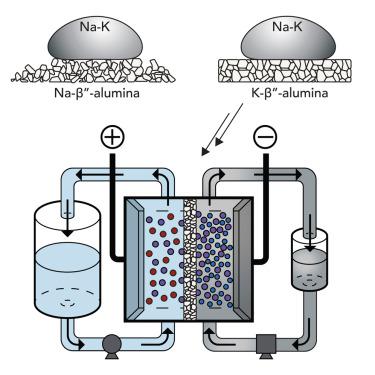Joule ( IF 38.6 ) Pub Date : 2018-05-02 , DOI: 10.1016/j.joule.2018.04.008 Antonio C. Baclig , Geoff McConohy , Andrey Poletayev , Aaron Michelson , Nathan Kong , Joon-Hyung Lee , William C. Chueh , Jason Rugolo

|
Flow batteries are a compelling grid-scale energy storage technology because the stored energy is decoupled from the system power. Aqueous redox flow batteries (RFBs), however, are limited by low open-circuit voltages (OCVs). Replacing the aqueous negative electrolyte (negolyte) with liquid alkali metals—of which Na-K, a room-temperature liquid metal alloy, is attractive—would increase the OCV considerably. However, a suitable solid electrolyte has not been reported for Na-K. Here we show that K-β″-alumina is a selective and robust K+ ion conductor in contact with Na-K, to which it is stable with minimal exchange of Na. We report the cycling of cells with OCVs of 3.1–3.4 V employing aqueous and nonaqueous positive electrolytes (posolytes), and power density tests showing promising maximum power densities of 65 mW cm−2 at 22°C and >100 mW cm−2 at 57°C, ohmically limited by 330-μm K-β″-alumina membranes. Further development of Na-K|K-β″-alumina batteries could unlock cost-effective energy storage.
中文翻译:

Na-K |K-β″-氧化铝稳定性可实现高压,室温液态金属液流电池
液流电池是一种引人注目的网格规模储能技术,因为所存储的能量与系统电源分离。但是,水性氧化还原液流电池(RFB)受低开路电压(OCV)的限制。用液态碱金属(其中Na-K(一种室温液态金属合金)是有吸引力的)代替含水负电解液(电解质)会大大提高OCV。然而,尚未报道用于Na-K的合适的固体电解质。在这里,我们证明K-β″-氧化铝是一种选择性且坚固的K +与Na-K接触的离子导体,它对Na的交换稳定,而Na的交换最少。我们报告细胞的循环与采用3.1-3.4的V的OCV水性和非水性正电解质(posolytes),和功率密度测试结果,显示有希望的65毫瓦厘米的最大功率密度-2在22℃和> 100毫瓦厘米-2在57°C,由330-μmK-β''-氧化铝膜欧姆限制。Na-K |K-β''-氧化铝电池的进一步开发可以释放具有成本效益的储能。











































 京公网安备 11010802027423号
京公网安备 11010802027423号